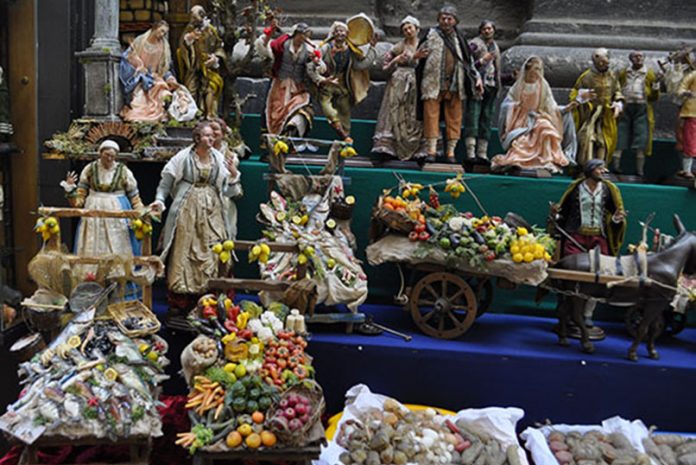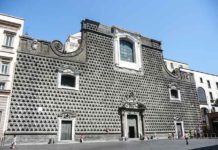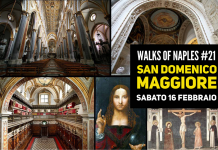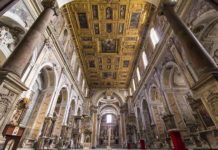The presence of craftsmen in San Gregorio Armeno street, the Neapolitan street of cribs, was due to the existence, during the centuries, of the Roman empire. Especially that of an ancient temple devoted to the goddess Cerere to which the citizens used to offer, as an ex-voto, small terracotta statues that were made in the shops of the area
Via San Gregorio Armeno, in the historical center of Naples, is for everyone the “street of cribs”. It is one of the most famous places in the world, and every year, the destination of thousands of tourists abducted by the timeless charm of the shops of master craftsmen of crib art.
The street takes its name from the religious complex dedicated to San Gregorio Armeno: an authentic jewel of Neapolitan Baroque architecture, which includes the church (inside of which stands the coffered ceiling, made in 1580 by the painter Teodoro d’Errico), the convent with its extraordinary cloister, considered among the most beautiful of all the city, where, among the fragrant citrus trees, stands a large marble fountain with the eighteenth-century statues of Christ and the Good Samaritan.
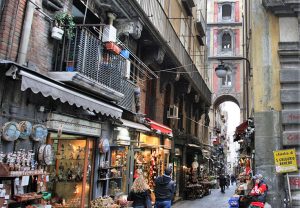
Also known as Via San Liguoro, the ancient street is of Greek origins, like the entire cross-section surrounding it: winding alleyways intersecting at right angles, as per the plan designed by the architect Hippodamo from Mileto and then exported to the colonies of Magna Grecia. It is no coincidence that it perpendicularly connects the two main Decumans: the largest one (the current via dei Tribunali) and the lower one (the modern Spaccanapoli).
During the fifteenth century, the alley that extends to the former agora (near San Gaetano Square), took the name of Strada Nostriana from the name of the then bishop of Naples, Nostriano, who here raised the the first hospital for the sick and poor. The building was only later t identified by the name of the Bishop of Armenia, to whom, since 1205, a small church was dedicated, founded by a group of Basilian nuns.
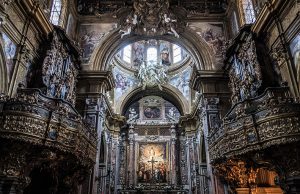
According to legend, this building, now known as San Gregorio Armeno (or San Biagio Maggiore), was built in 930, on the site of a church erected by Sant’Elena, Emperor Constantine’s mother, on the ruins of a pagan temple devoted to the goddess Ceres. But it is much more likely that they were the nuns of San Basilio, (eighth century), founded the monastery that in 1009 was joined by a flyover, to that of San Pantaleone and San Sebastiano.
It is said that the Sisters had come to Naples led or inspired by Saint Patrizia of Constantinople, escaping from the oriental iconoclast, carrying with them the remains of St. Gregory the Illuminator, Patriarch of Armenia (257-331). They founded a first monastery after landing on the island of Megaride (Castel dell’Ovo). After the death of their founder and by the will of the Byzantine duke Stefano, the nuns took her body in procession through the streets of the city. At one point the two white heifers pulling the funeral wagon suddenly stopped: the event was considered to be the led by the will of the virgin Patrizia. Hence the decision to move the monastery to its present place.
The structure, over the centuries, has been restored several times. In particular since 1572, after the Council of Trent. And just on the overpass joining the two sides of the road, following the numerous restorations, the bell tower was built. Today this bell tower represents one of the most characteristic sights of the Old Center of Naples.
The Sisters could not know, however, that one day many centuries later, their saint who had literally “pushed” them along the Nostraan Road and to whom they were so devoted, would be worshiped in their own convent. Initially buried in the ancient monastery of Saints Nicandro and Marciano, in 1864, the remains of the noblewoman of Constantinople (sanctified in 1625) were transferred to San Gregorio Armeno and, since 1922, have been entrusted to the custody of the Crouching Adorers of the Eucharist.
Santa Patrizia (Saint Patricia), co-patron of Naples, is the protector of young maids seeking a husband, sailors, parturients and the needy. Her cult is linked to the prodigal of blood liquefaction, similar to that of Saint Gennaro. This is said to have taken place over the years in different ways and times. But according to tradition, it takes place every Tuesday and on the feast day of St. Patrizia, on August, 25.
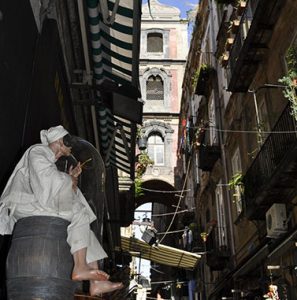
In the crib street, the monastery of Saint Patrizia is to be found. Near the intersection with Via San Biagio dei Librai, just on its left, is another church, the one of Saint Gennaro all’Olmo. Here the philosopher Giambattista Vico was baptized. And across the street, on the opposite side, is the church that is traditionally considered the domus Ianuaria, the birthplace of San Gennaro.
And now we come to the famous crib art. For some, the presence of craftsmen in this street was due to the existence, during the centuries, of the Roman empire. Especially that of an ancient temple devoted to the goddess Cerere (as the one mentioned above relative to the convent of San Gregorio Armeno) to which the citizens used to offer, as an ex-voto, small terracotta statues that were made nearby, in the shops of the area.
The birth of the Neapolitan crib obviously came about much later and dates back to the late eighteenth century. But nothing prevents us from hypothesizing that history, myth and tradition may have fused, in the passage from the old to the new religion and that the ancient artists have simply gone from making statues to that of shepherds. The fact remains that along this long narrow street that goes from Via San Biagio of the Libraans to Via dei Tribunali, uniting both streets, dozens of workshops, that throughout the whole year, work hard to produce all the elements and characters of the crib.

 Italiano
Italiano

